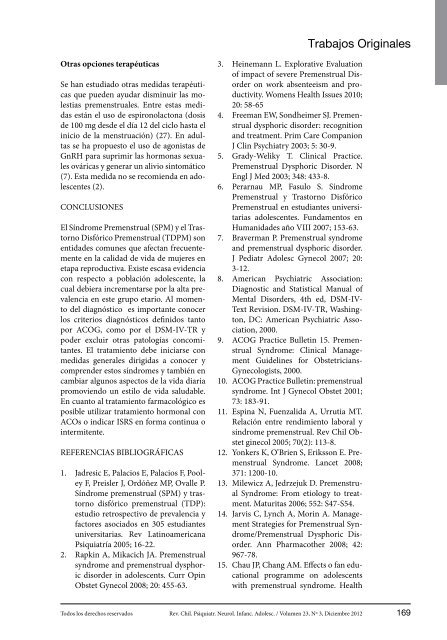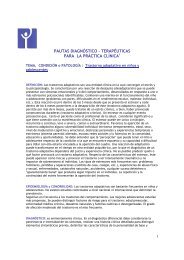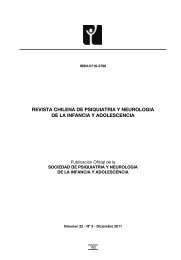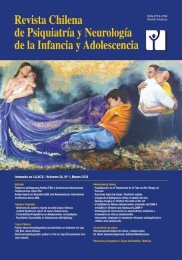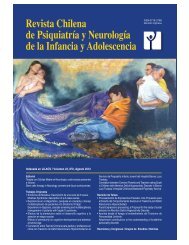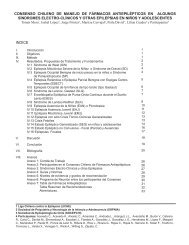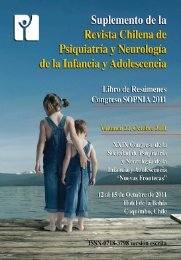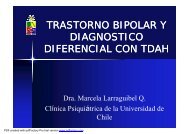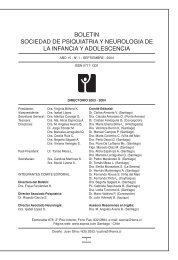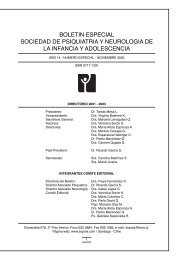Untitled - Sociedad de PsiquiatrÃa y NeurologÃa de la Infancia y ...
Untitled - Sociedad de PsiquiatrÃa y NeurologÃa de la Infancia y ...
Untitled - Sociedad de PsiquiatrÃa y NeurologÃa de la Infancia y ...
You also want an ePaper? Increase the reach of your titles
YUMPU automatically turns print PDFs into web optimized ePapers that Google loves.
Trabajos Originales<br />
Otras opciones terapéuticas<br />
Se han estudiado otras medidas terapéuticas<br />
que pue<strong>de</strong>n ayudar disminuir <strong>la</strong>s molestias<br />
premenstruales. Entre estas medidas<br />
están el uso <strong>de</strong> espirono<strong>la</strong>ctona (dosis<br />
<strong>de</strong> 100 mg <strong>de</strong>s<strong>de</strong> el día 12 <strong>de</strong>l ciclo hasta el<br />
inicio <strong>de</strong> <strong>la</strong> menstruación) (27). En adultas<br />
se ha propuesto el uso <strong>de</strong> agonistas <strong>de</strong><br />
GnRH para suprimir <strong>la</strong>s hormonas sexuales<br />
ováricas y generar un alivio sintomático<br />
(7). Esta medida no se recomienda en adolescentes<br />
(2).<br />
CONCLUSIONES<br />
El Síndrome Premenstrual (SPM) y el Trastorno<br />
Disfórico Premenstrual (TDPM) son<br />
entida<strong>de</strong>s comunes que afectan frecuentemente<br />
en <strong>la</strong> calidad <strong>de</strong> vida <strong>de</strong> mujeres en<br />
etapa reproductiva. Existe escasa evi<strong>de</strong>ncia<br />
con respecto a pob<strong>la</strong>ción adolescente, <strong>la</strong><br />
cual <strong>de</strong>biera incrementarse por <strong>la</strong> alta prevalencia<br />
en este grupo etario. Al momento<br />
<strong>de</strong>l diagnóstico es importante conocer<br />
los criterios diagnósticos <strong>de</strong>finidos tanto<br />
por ACOG, como por el DSM-IV-TR y<br />
po<strong>de</strong>r excluir otras patologías concomitantes.<br />
El tratamiento <strong>de</strong>be iniciarse con<br />
medidas generales dirigidas a conocer y<br />
compren<strong>de</strong>r estos síndromes y también en<br />
cambiar algunos aspectos <strong>de</strong> <strong>la</strong> vida diaria<br />
promoviendo un estilo <strong>de</strong> vida saludable.<br />
En cuanto al tratamiento farmacológico es<br />
posible utilizar tratamiento hormonal con<br />
ACOs o indicar ISRS en forma continua o<br />
intermitente.<br />
REFERENCIAS BIBLIOGRÁFICAS<br />
1. Jadresic E, Pa<strong>la</strong>cios E, Pa<strong>la</strong>cios F, Pooley<br />
F, Preisler J, Ordóñez MP, Ovalle P.<br />
Síndrome premenstrual (SPM) y trastorno<br />
disfórico premenstrual (TDP):<br />
estudio retrospectivo <strong>de</strong> prevalencia y<br />
factores asociados en 305 estudiantes<br />
universitarias. Rev Latinoamericana<br />
Psiquiatría 2005; 16-22.<br />
2. Rapkin A, Mikacich JA. Premenstrual<br />
syndrome and premenstrual dysphoric<br />
disor<strong>de</strong>r in adolescents. Curr Opin<br />
Obstet Gynecol 2008; 20: 455-63.<br />
3. Heinemann L. Explorative Evaluation<br />
of impact of severe Premenstrual Disor<strong>de</strong>r<br />
on work absenteeism and productivity.<br />
Womens Health Issues 2010;<br />
20: 58-65<br />
4. Freeman EW, Sondheimer SJ. Premenstrual<br />
dysphoric disor<strong>de</strong>r: recognition<br />
and treatment. Prim Care Companion<br />
J Clin Psychiatry 2003; 5: 30-9.<br />
5. Grady-Weliky T. Clinical Practice.<br />
Premenstrual Dysphoric Disor<strong>de</strong>r. N<br />
Engl J Med 2003; 348: 433-8.<br />
6. Perarnau MP, Fasulo S. Síndrome<br />
Premenstrual y Trastorno Disfórico<br />
Premenstrual en estudiantes universitarias<br />
adolescentes. Fundamentos en<br />
Humanida<strong>de</strong>s año VIII 2007; 153-63.<br />
7. Braverman P. Premenstrual syndrome<br />
and premenstrual dysphoric disor<strong>de</strong>r.<br />
J Pediatr Adolesc Gynecol 2007; 20:<br />
3-12.<br />
8. American Psychiatric Association:<br />
Diagnostic and Statistical Manual of<br />
Mental Disor<strong>de</strong>rs, 4th ed, DSM-IV-<br />
Text Revision. DSM-IV-TR, Washington,<br />
DC: American Psychiatric Association,<br />
2000.<br />
9. ACOG Practice Bulletin 15. Premenstrual<br />
Syndrome: Clinical Management<br />
Gui<strong>de</strong>lines for Obstetricians-<br />
Gynecologists, 2000.<br />
10. ACOG Practice Bulletin: premenstrual<br />
syndrome. Int J Gynecol Obstet 2001;<br />
73: 183-91.<br />
11. Espina N, Fuenzalida A, Urrutia MT.<br />
Re<strong>la</strong>ción entre rendimiento <strong>la</strong>boral y<br />
síndrome premenstrual. Rev Chil Obstet<br />
ginecol 2005; 70(2): 113-8.<br />
12. Yonkers K, O’Brien S, Eriksson E. Premenstrual<br />
Syndrome. Lancet 2008;<br />
371: 1200-10.<br />
13. Milewicz A, Jedrzejuk D. Premenstrual<br />
Syndrome: From etiology to treatment.<br />
Maturitas 2006; 552: S47-S54.<br />
14. Jarvis C, Lynch A, Morin A. Management<br />
Strategies for Premenstrual Syndrome/Premenstrual<br />
Dysphoric Disor<strong>de</strong>r.<br />
Ann Pharmacother 2008; 42:<br />
967-78.<br />
15. Chau JP, Chang AM. Effects o fan educational<br />
programme on adolescents<br />
with premenstrual syndrome. Health<br />
Todos los <strong>de</strong>rechos reservados Rev. Chil. Psiquiatr. Neurol. Infanc. Adolesc. / Volumen 23, Nº 3, Diciembre 2012<br />
169


